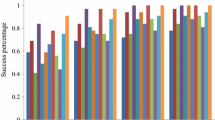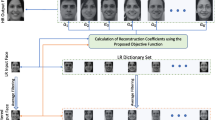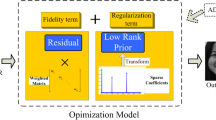Abstract
It is known that image priors are essential to blind deconvolution. Reweighted graph total variation (RGTV), as a new prior to substitute the most classical total variation (TV), has been shown superior to TV and several other cutting-edge models both theoretically and empirically. This paper steps forward, firstly providing a simpler geometric perspective to RGTV in the framework of variational partial differential equations (PDEs), rather than the previous graph spectral interpretation made in the graph frequency domain. Surprisingly, a slight shift of perspective as such finally leads to a huge blind deblurring performance boosting in both accuracy and efficiency as compared to the previously derived numerical approach, which approximates RGTV as the graph L1-Laplacian regularizer. Utilizing the simplified RGTV as reformulated in this paper, another valuable contribution is an exploration of its potentials for blind facial image restoration by combining unsupervised deep facial models. Experimental results of blind face deblurring and blind face hallucination both demonstrate necessity and rationale of a joint model-based and learning-based approach to blind face restoration.










Similar content being viewed by others
Data availability
The data that support the findings of this study are partly available from https://github.com/continue-cmd/results.
References
Eqtedaei, A., Ahmadyfard, A.: Coarse-to-fine blind image deblurring based on K-means clustering. Vis. Comput. 12, 36–415 (2023). https://doi.org/10.1007/s00371-023-02785-2
Parvaz, R.: Point spread function estimation for blind image deblurring problems based on framelet transform. Vis. Comput. (2022). https://doi.org/10.1007/s00371-022-02484-4
Lai, W.S., Huang, J.B., Hu, Z., Ahuja, N., Yang, M.H.: A comparative study for single image blind deblurring. In: CVPR, pp. 1701–1709 (2016)
Pan, J., Hu, Z., Su, Z., Yang, M.-H.: L0-regularized intensity and gradient prior for deblurring text images and beyond. IEEE Trans. PAMI 39(2), 342–355 (2017)
Pan, J., Sun, D., Pfister, H., Yang, M.H.: Deblurring images via dark channel prior. In: IEEE Transactions PAMI, pp. 2315–2328 (2018)
Yan, Y., Ren, W., Guo, Y., Wang, R., Cao, X.: Image deblurring via extreme channels prior. In: CVPR (2017)
Li, L., Pan, J., Lai, W.-S., Gao, C., Sang, N., Yang, M.-H.: Blind image deblurring via deep discriminative priors. Int. J. Comput. Vis. 127(8), 1025–1043 (2019)
Wen, F., Ying, R., Liu, Y., Liu, P., Truong, T.-K.: A simple local minimal intensity prior and an improved algorithm for blind image deblurring. In: IEEE Transactions Circuits and Systems for Video Technology, pp. 2923–2937 (2021)
Chen, L., Fang, F., Wang, T., Zhang, G.: Blind image deblurring with local maximum gradient prior. In: CVPR, pp. 1742–1750 (2019)
Xu, Z., Chen, H., Li, Z.: Fast blind deconvolution using a deeper sparse patch-wise maximum gradient prior. Signal Process.: Image Commun. 90, 116050 (2021)
Levin, A., Weiss, Y., Durand, F., Freeman, W.T.: Understanding blind deconvolution algorithms. IEEE Trans. PAMI 33(12), 2354–2367 (2011)
Pan, J., Su, Z.: Fast L0-regularized kernel estimation for robust motion deblurring. IEEE Signal Process. Lett. 20(9), 1107–1114 (2013)
Xu, L., Zheng, S., Jia, J.: Unnatural L0 sparse representation for natural image deblurring. In: IEEE Conferences of Computer Vision and Pattern Recognition, pp. 1107–1114 (2013)
Shearer, P., Gilbert, A.C., Hero III, A.O.: Correcting camera shake by incremental sparse approximation. In: ICIP pp. 572–576 (2013)
Krishnan, D., Tay, T., Fergus, R.: Blind deconvolution using a normalized sparsity measure. In: CVPR pp. 233–240 (2011)
Bai, Y., Cheung, G., Liu, X., Gao, W.: Graph-based blind image deblurring from a single photograph. IEEE TIP 28(3), 1404–1418 (2019)
Chan, T.F., Wong, C.K.: Total variation blind deconvolution. IEEE TIP 7(3), 370–375 (1998)
Cho, S., Lee, S.: Fast motion deblurring. ACM Trans. Graph. 28(5), 1–8 (2009)
Xu, L., Jia, J.: Two-phase Kernel estimation for robust motion deblurring. In: ECCV, pp. 157–170 (2010)
Sapiro, G.: Geometric Partial Differential Equations and Image Analysis. Cambridge University Press, Cambridge (2001)
Karras, T., Aila, T., Laine, S., Lehtinen, J.: Progressive growing of GANs for improved quality, stability, and variation. In: ICLR (2018).
Karras, T., Laine, S., Aila, T.: A style-based generator architecture for generative adversarial networks. In: CVPR (2019)
Elmoataz, A., Lézoray, O., Bougleux, S.: Nonlocal discrete regularization on weighted graphs: a framework for image and manifold processing. IEEE Trans. Image Process. 17(7), 1047–1060 (2008)
Hidane, M., Lézoray, O., Elmoataz, A.: Nonlinear multilayered representation of graph-signals. J. Math. Imaging Vis. 45(2), 114–137 (2013)
Couprie, C., Grady, L., Najman, L., Pesquet, J.-C., Talbot, H.: Dual constrained TV-based regularization on graphs. SIAM J. Imag. Sci. 6(3), 1246–1273 (2013)
Berger, P., Hannak, G., Matz, G.: Graph signal recovery via primal dual algorithms for total variation minimization. IEEE J. Sel. Topics Signal Process. 11(6), 842–855 (2017)
Shuman, D.I., Narang, S.K., Frossard, P., Ortega, A., Vandergheynst, P.: The emerging field of signal processing on graphs: extending high-dimensional data analysis to networks and other irregular domains. IEEE Signal Process. Mag. 30(3), 83–98 (2013)
Pang, J., Cheung, G.: Graph Laplacian regularization for image denoising: analysis in the continuous domain. IEEE Trans. Image Process. 26(4), 1770–1785 (2017)
Huber, P.J., Ronchetti, E.M.: Robust Statistics, 2nd edn. Wiley series in probability and statistics (2009)
Aubert, G., Kornprobst, P.: Mathematical Problems in Image Processing. Springer, New York (2002)
Ren, D., Zhang, K., Wang, Q., Hu, Q., Zuo, W.: Neural blind deconvolution using deep priors. In: CVPR (2020)
Yang, T., Ren, P., Xie, X., Zhang, L.: GAN prior embedded network for blind face restoration in the wild. In: CVPR (2021)
Wang, X., Li, Y., Zhang, H., Shan, Y.: GFP-GAN: towards real-world blind face restoration with generative facial prior. In: CVPR (2021)
Chen, C., Li, X., Yang, L., Lin, X., Wong, K., Y.K.: Progressive semantic-aware style transformation for blind face restoration. In: CVPR (2021)
Bulat, A., Yang, J., Tzimiropoulos, G.: To learn image super-resolution, use a GAN to learn how to do image degradation first. In: ECCV (2018)
Asim, M., Shamshad, F., Ahmed, A.: Blind Image Deconvolution Using Deep Generative Priors. IEEE Trans. Comput. Imaging 6, 1493–1506 (2020)
Boracchi, G., Foi, A., et al.: Modeling the performance of image restoration from motion Blur. IEEE Trans. Image Process. 21(8), 3502–3517 (2012)
Kingma, D.P. Ba, J.: Adam: a method for stochastic optimization. In: ICLR (2015)
Schuler, C., Hirsch, M., Harmeling, S., Scholkopf, B.: Learning to Deblur. IEEE Trans. Pattern Anal. Mach. Intell. 38(7), 1439–1451 (2016)
Dong, J., Pan, J., Su, Z., Yang, M.-H.: Blind image deblurring with outlier handling. In: ICCV (2017)
Pan, J., Dong, J., Tai, Y.-W., Su, Z., Yang, M.-H.: Learning discriminative data fitting functions for blind image deblurring. In: ICCV (2017)
Acknowledgements
The work was supported in part by the Natural Science Foundation of China (61771250, 61972213, 11901299) and in part by the Fundamental Research Funds for the Central Universities (30918014108).
Author information
Authors and Affiliations
Corresponding author
Ethics declarations
Conflict of interest
The authors declare that they have no known competing financial interests or personal relationships that could have appeared to influence the work reported in this paper.
Additional information
Publisher's Note
Springer Nature remains neutral with regard to jurisdictional claims in published maps and institutional affiliations.
Rights and permissions
Springer Nature or its licensor (e.g. a society or other partner) holds exclusive rights to this article under a publishing agreement with the author(s) or other rightsholder(s); author self-archiving of the accepted manuscript version of this article is solely governed by the terms of such publishing agreement and applicable law.
About this article
Cite this article
Shao, WZ., Deng, HS., Luo, WW. et al. Revisiting reweighted graph total variation blind deconvolution and beyond. Vis Comput 40, 3119–3135 (2024). https://doi.org/10.1007/s00371-023-03014-6
Accepted:
Published:
Issue Date:
DOI: https://doi.org/10.1007/s00371-023-03014-6




